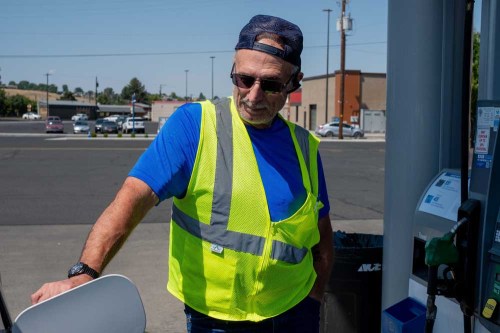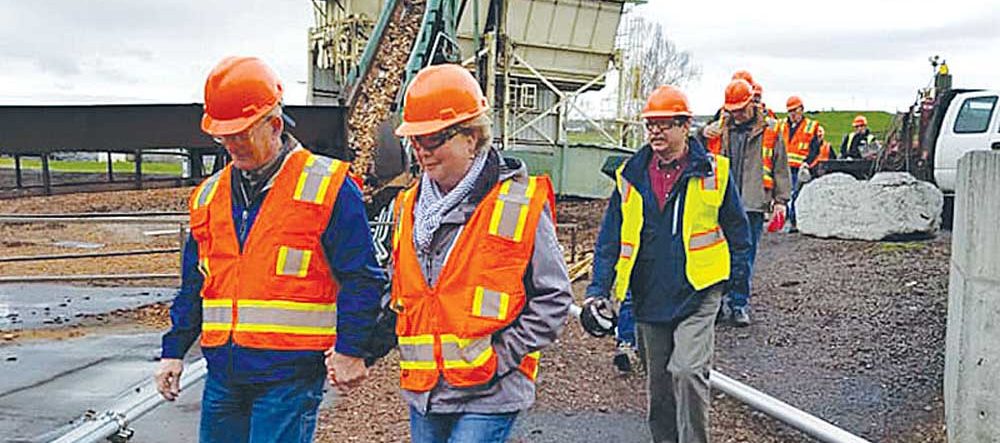AAA: Self-service won’t reduce gas prices
Published 10:00 am Friday, August 18, 2023

- Fred Jensen of Richland, Washington, talks about his support for self-service gas July 10, 2023, as he pumps his own gas at Dave’s Chevron in Pendleton. Marie Dodds, the director of government and public affairs for AAA Oregon/Idaho, reports the move to legalize self-service gas will not reduce the state’s high fuel prices.
SALEM — Legalizing self-service gas will not reduce Oregon’s historically high prices, according to Marie Dodds, the director of government and public affairs for AAA Oregon/Idaho.
In fact, the bill passed by the 2023 Oregon Legislature requires that self-service gas not be any cheaper than gas pumped by attendants, which the new law still requires most stations to provide.
Dodds’ organization and several others supported the provision because they did not want those who have trouble pumping their own gas — the elderly, the disabled, and those dressed up for work or social occasions — to pay higher prices.
“There are people who cannot easily pump their own gas and those who prefer not to, and we do not believe they should be penalized,” said Dodds, who compiles and posts a weekly comparison of gas prices on her organization’s website.
More than that, Dodds said research shows Oregon’s previous ban against self-service was not a significant factor in price of gas. The same is true in New Jersey, the only state that now completely bans self-service.
The federal government includes Oregon in a seven-state region known as Petroleum Administration for Defense Districts V (padd 5). The other states are Alaska, Arizona, California, Hawaii, Nevada and Washington. According to Dodds, the entire region has historically had the highest gas prices in the country. Only Oregon banned self-service until the new law took effect on Aug. 4.
“I have worked here for 15 years and they have almost always been in the top 10. Oregon is usually number four, five or six,” Dodds said.
As reported on the AAA website, the average price of gas in Oregon this week was $4.69 compared to the national average of $3.86. But the price in Vancouver was higher than Portland — $5.03 compared to $4.77 — even though Washington has allowed self-service much longer than Oregon.
There are several reasons why the western states have historically had higher gas prices. One is because they are relatively far away from where most gas is pumped and refined. That results in higher transportation and storage costs before the gas is even delivered to the stations.
The wages paid to truck drivers have also jumped significantly because of the labor shortage that started during the COVID-19 pandemic and is still impacting other industries, too. According to Gabriel Zirkle, the president of the Oregon Fuels Association, the wages have jumped from $22 to $40.
Cost also can jump if refineries in other parts of the country are shut down for maintenance or by accidents.
“There’s not enough refining capacity to meet demand in the West Coast. So not only are prices elevated often in Washington and Oregon, but California as well,” said Patrick De Haan, the head of petroleum analysis for GasBuddy, a website that also tracks gas prices and offers driving services.
Some of the Western states also have environmental regulations that increase prices, Dodds said. They include California, which restricts the kind of gas that can sold to reduce pollution. Some also have complex cap-and-trade programs intended to reduce greenhouse gas emissions, including Oregon.
Another factor is gas taxes. At 38 cents-per-gallon, Oregon’s gas tax is well below Washington, which leads the nation at 49.4 cents. But several cities in the state have enacted their own gas taxes, including Portland, which is collecting 10 cent-a-gallon for street maintenance and safety project.
Even international events can affect Oregon gas prices.
“Crude oil prices are up about 15% since July 1, driven in part by Saudi Arabia’s extension of its production cuts of one million barrels a day through September,” the website said.
A recent poll by the Oregon Values and Beliefs Center, a project of DHM Research, found that a majority of state residents are ready to pump their own gas. Nearly two-thirds said they would rather do that than rely on attendants. They just shouldn’t allow the new option to reduce prices.









